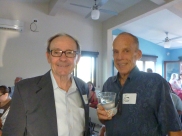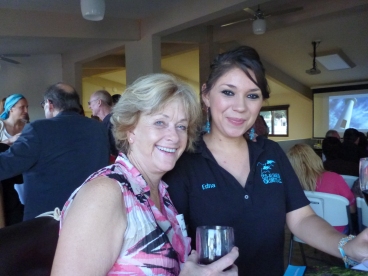[first published by The Ocean Foundation, November 6, 2013]
Imagine ….
Imagine … a cadre of youth educated and dedicated to protecting and nurturing their environment and sharing that knowledge with family and friends …
Imagine … a group of energetic hands-on volunteers committed to solving local issues of water quality, waste management and resource protection …
Imagine … a community center where like-minded individuals come together, a gathering space for researchers, government organizations, local partners and fishermen to chart paths to preserve natural resources and their ways of life …
Imagine … a staff of talented enthusiastic leaders guiding and directing activities of such a center with outreach programs in support of environmental goals …
Imagine … partners, sponsors, supporters, and Directors with the resources and connections to fund and support a foothold and voice in the stewardship of a wide range of environmental activities …
Imagine … relentless visionaries with tireless energy determined to make a difference, to manifest a dream, in a small seaside city …
Imagine these things … and then stop imagining, because they are real.

CenCoMa Building (Photo Credit: Rick Jackson)
On October 19, 2013, the Community Center for the Environment, CenCoMA (Centro Comunitario para el Medio Ambiente), in Loreto, BCS, Mexico celebrated its formal dedication. Over 150 people turned out in support of the celebration, which began a blessing by the Padre of Our Lady of Loreto Mission, and was followed by a ribbon cutting by the representatives from the Local government, the Director of the Bay of Loreto National Park, Everardo Mariano Melendez, and Yvo Arias Salorio, Board President.
Delicious food and beverages were served to the enthusiastic guests who toured the new facility. A large screen display provided a backdrop amongst the café tables set up for the event, with images that illustrated some of the perils that challenge the local environment The dedication solidified the physical framework of an on-going dream, where making a difference isn’t just something spoken, but actually taking place on a day-to-day basis.

Advisory Board Members/ Richard Jackson, Jill Jackson, Charles Mitchel and Roberto Lopez (Photo Credit: Rick Jackson).
At the heart of CenCoMA is Eco-Alianza de Loreto, founded in 2007 by a group of concerned citizens and friends in the Loreto municipality to support smart growth strategies in response to rapid development by outside interests. Over the past six years, Eco-Alianza has strived to establish a sustainable community devoted to conserving the abundance and diversity of terrestrial and marine life.
In less than a year since it’s opening, CenCoMA has already become a valued asset to the community of Loreto. The Center is strategically located in the center of town and was made possible through a gift by the Linda and Anthony Kinninger Trust. Renovations converted the property to offices and a public meeting space and were made possible by a donation from Engineer Hugo Quintero Maldonado, founding President of Eco-Alianza, Kathryn and Charles Mitchell, and an anonymous donation from a U.S. foundation.
The Center currently houses a Water Quality Lab for testing and office space for a professional staff of eight who conduct programs that include:
- A Campaign for a Clean Loreto
- Citizen Monitoring of our Marine Environment
- Loretanos for a “Sea Full of Life”
- Sustainable Fisheries Project
- The Loreto Watershed Conservation Campaign
- The Environmental Leadership Club
- Environmental Education for Loreto Youth and Community
- Outreach programs to celebrate conservation days, such as Earth Day, World Ocean Day, World Environment Day, World Water Day, Recycling Day
Along with those programs, Eco-Alianza is working with Loreto’s decision-makers to create responsible growth policies, a watershed conservation ecological ordinance, and fisheries regulations. It is hoped that these endeavors will become an example for other coastal communities to follow worldwide.

Caption: Tony Kinninger, Kenneth Quintero, Hugo Quintero, Lorenzo Ochoa, Everardo Mariano, Linda Kinninger, Horacio Cabrera, Jorge Magdaleno, Antonio Verdugo, Mayra Gpe Lopez Lemus, Lizandro Soto, and Lizandro Soto Martinez (Photo Credit: Rick Jackson).
Eco-Alianza has embarked on collaborative effort to establish a “Sister Park” program to advance eco-tourism and job opportunity in the region. To support this endeavor, it has partnered with the Bay of Loreto National Park, the Channel Islands National Park, the University of California Santa Barbara, and the Nature Conservancy.
The Center allows Eco-Alianza to expand its program capability, visibility, and outreach. The Center will serve as a permanent symbol of conservation and preservation for the entire Loreto region for generations to come.
The Ocean Foundation (TOF) has been an integral part of Eco-Alizana since its inauguration. TOF President, Mark Spalding and Vice-President of Programs, Kama Dean are members of the Eco-Alianza Advisory Board. TOF has supported educational programs, the annual calendar, and general activities. The original funding for the “Pride Campaign,” as well as a fisheries program begun by RARE Conservation were provided by TOF. Advisory support was provided for CenCoMA.
Phase II of the expansion of the CenCoMA facility has just begun. A fundraising campaign is underway to build a Natural History Museum and an Interpretive Learning Center on the property to support of the Bay of Loreto National Park and the Sierra de la Giganta region.
To continue the expansion of CenCoMA and help further the efforts of Eco-Alianza and its programs, your help is needed. To find our more information about Eco-Alianza’s programs, or to make a donation, please visit Eco-Alianza’s website at: www.ecoalianzaloreto.org.
Donations are tax deductible in the U.S.A. or through our fiscal sponsor in the U.S.A., The Ocean Foundation. Click here to donate!
Thank you for being part of our dream.

Sign In Desk

Edna Peralta, Staff Member and Jill Jackson

Linda and Tony Kinninger

Hugo Quintero

Lobby Activities

Upstairs Gathering

Tony Kinninger & Jim Petit

Guests and Supporters

Angela Place, Pamla Alley, Patty Ferentino

Barbara Jordan, Carol Boyd and Lynn Hammon

Projection Screen

Lynn Hammon and Edna Peralta

Charlie & Teri

Guests and Supporters
































You must be logged in to post a comment.